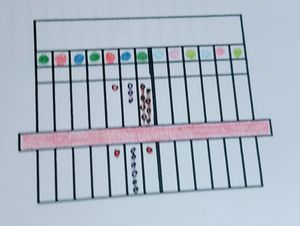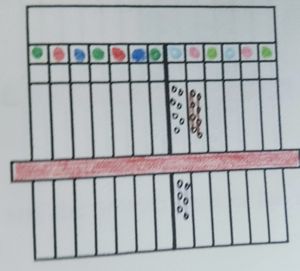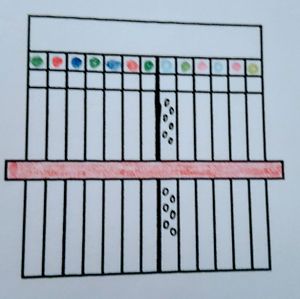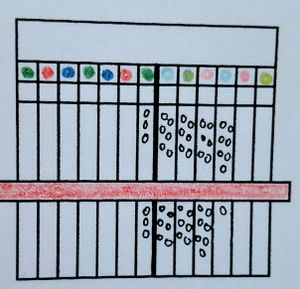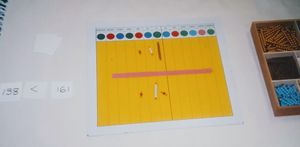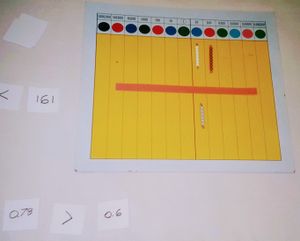Decimals Comparing Decimal Numbers (lesson 9)
Contents
Age
9-12
Materials
- Decimal board
- Decimal beads and disks
- Cardboard strip as long as the decimal board
- Prepared problems
- Paper and pencil
- Optional/Alternative: Montessori bead bars
Preparation
Students should have had the Decimal Lessons 1-8 (We are moving from the concrete toward the abstract).
Presentation
- Teacher can choose to use bead bars for this lesson to help make an impression for the difference in values.
- 1. "In this activity we're going to compare two numbers to see which is the larger, or whether both are equal to each other. Let's start with two whole numbers, so we can see the steps to follow."
- 2. Place the cardboard strip horizontally across the middle of the decimal board. Above the strip, form the quantity 138 with the beads; below the strip, form the quantity 161 (Teacher can choose to write the numeral on a slip, put at the bottom of Decimal Board)
- 3. "How do we know which number is larger? They both have the same number of hundreds, so we can't tell from that. One number has three tens, and the other has six. The number with six tens will be larger, regardless of any other differences after that."
Even if the first number were 139.999999999, and the other numbers were 160.000000000, the first number would still be smaller because it has fewer tens.
- 4. Replace the beads, and form the next pair of numbers on the board. In the top half, form the numeral 0.78. In the bottom half, form 0.6
"Are there any whole numbers (hundreds, tens, units) at all in either number?" (no) "So we can't tell from the whole numbers which is the larger number. Let's go on the the tenths."
- 5. "The top number has seven tenths. The bottom number has six tenths. We don't have to look any further. The top number is larger, no matter what the rest of the number looks like." Invite the students to write this statement in their Math Journals: 0.78 > 0.6
- 6. Remove the disks, and form the next pair of numbers: 0.6 in the top and 0.60 in the bottom.
Compare whole numbers: neither number has any compare tenths: both numbers have six tenths: both numbers have six tenths. compare hundredths and other categories after that: neither number has any.
Both numbers are equal. Direct the students to write a statement in their Math journal: 0.6 = 0.60
Point out to the student that we can add zeros forever to the right of either number, and the value of the number wouldn't change.
- 7. Continue with other number pairs, increasing the level of difficulty gradually as you go. An example of a more complicated one is:
form 3.6667 in the top half, and 3.6671 in the bottom half.
"Compare whole numbers: both are equal there. Compare tenths: both have six. Compare hundredths: both have six."
"Compare thousandths: the top number has six the bottom number has seven. It is larger regardless of anything else after that."
Extension: Ordering three decimal numbers from least to greatest.
Control Of Error
Teacher guided.
Points Of Interest
Participating with the new knowledge helps move the concrete experiences toward abstract thinking
Purpose
- To make a visual, auditory and kinesthetic impression upon the child on how whole numbers are divided into smaller units-decimals.
Variation
Alternative: Use bead bars instead of beads and disks:
138 < 161:
0.78 > 0.6
Handouts/Attachment
